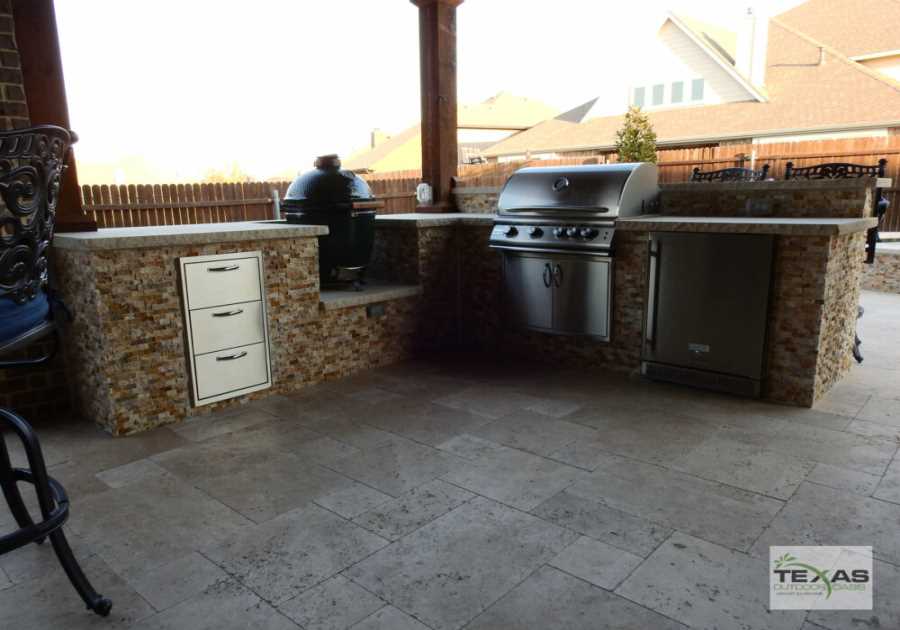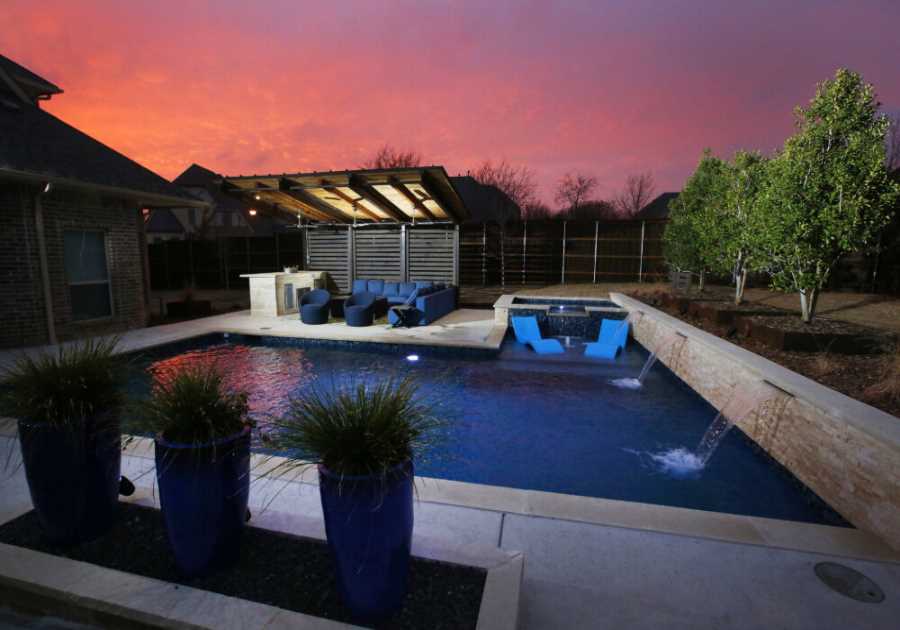“Half a million years ago, the world witnessed a revolution. An ape-like creature destined to become man became the first animal to cook its dinner. The mastery of fire by Homo erectus around 500,000 BCE resulted in nothing less than the rise of civilization.”
I wrote these lines at the start of a book that changed my life forever. That book was The Barbecue! Bible (I’ll explain the exclamation mark in a minute) and I like to think it launched the modern barbecue revolution.
The book went on to sell more than a million copies, with translations in a dozen languages. That it’s still in print a quarter century later speaks to the foresight of my publisher (more on that in a minute, too) and our enduring passion for live-fire cooking.
Some book ideas are the result of months or years of cogitation. The Barbecue! Bible came to me like a thunderbolt. The year was 1994 (second week of November); the place, my home in Coconut Grove, Florida. I remember the weather (a clear sunny day without an ounce of humidity); where I was sitting (on a white Adirondack chair on whose arm I liked to balance my laptop computer); and even what I was wearing (a white polo shirt and blue shorts).
Time slowed down, as it does at life-changing moments. It was almost as if I heard a voice from on high instructing me to “Follow the fire.”
Well, maybe it was a little less biblical than that. What the voice actually said was: “Grilling is the world’s oldest and most universal cooking method, but every culture does it differently. Wouldn’t it be cool to travel around the world and document how grilling varies from country to country?”
Normally, book proposals take weeks to write. I dashed this one off that afternoon. Normally proposals take weeks or months to be accepted or rejected (Miami Spice took 6 months). The next week I had a contract. My publisher, Workman Publishing, offered me more money than I had ever seen in my life.
It was only after I signed the contract that I realized what a colossal—make that mission impossible—project I had undertaken. I had pledged to travel around the world documenting grilling on every continent except Antarctica. When I started to look into airfares and hotel prices, the advance—generous as it was—would prove to be woefully inadequate.
I figured The Barbecue! Bible would take me a year to write. I’d visit a dozen countries. Develop 100 recipes. Then I could get back to what I was doing to make my real living at the time: writing books about healthy cooking.
Well, the The Barbecue! Bible grew to more than 500 recipes and took me four years to write. I spent that generous advance the first year, and I wound up writing four High-Flavor, Low-Fat cookbooks in the interim to fund the writing of this book.
It turned out there was SO much to say about barbecue. (Hey, it’s kept me busy and fascinated for the last 25 years). I’d probably still be writing The Barbecue! Bible today, if, at one point, my editor, Suzanne Rafer, ordered me to stop writing. “Not a single paragraph or recipe more,” she said. “Pull the paper out of the printer and send in what you’ve written so far, or we’ll never have a book we can publish.”
As you can imagine, I was late with the manuscript—like 3 years late. Normally, Spring books— and especially barbecue books—start arriving in booktores in April. We didn’t even have bound copies until June. Thanks to my compulsive desire to include everything I had learned during my travels, we missed two of the biggest grilling holidays of the year, Memorial Day and Father’s Day. We barely made it into bookstores by July 4th.
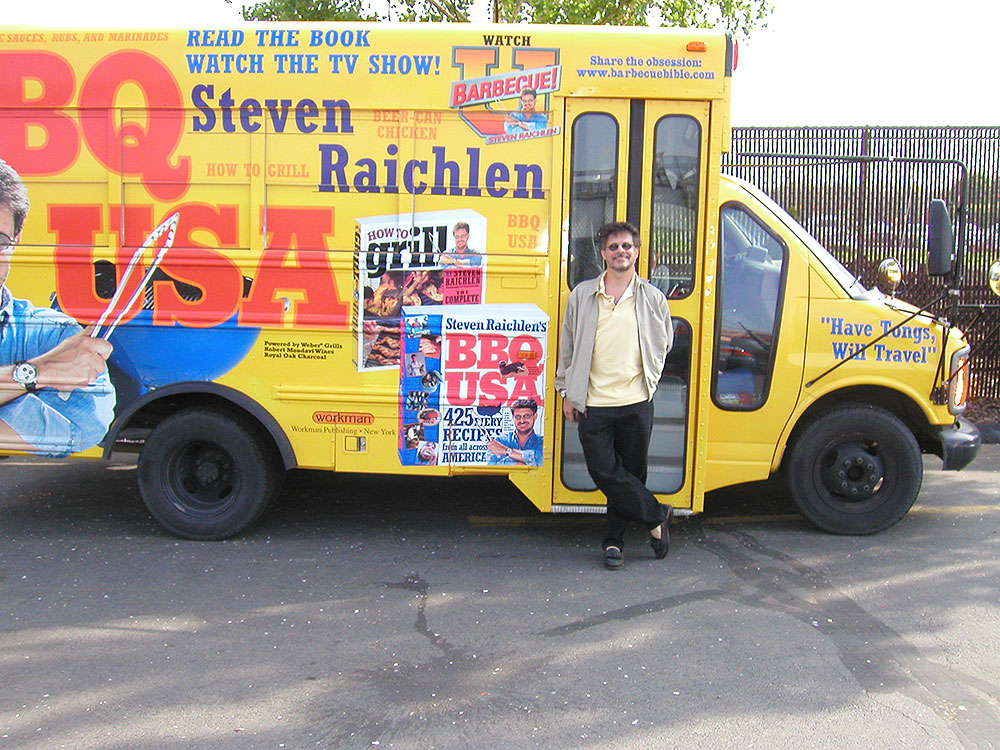
As it turned out, the delay was a godsend because most of the newspapers and magazines had already published their Spring grilling stories. A lot of the media wrote about the book the following year, so we had two seasons of publicity instead of one. One quote I particularly liked (from The New Yorker, no less): “For aspiring gourmets of the grill … there is only one book: The Barbecue! Bible.”
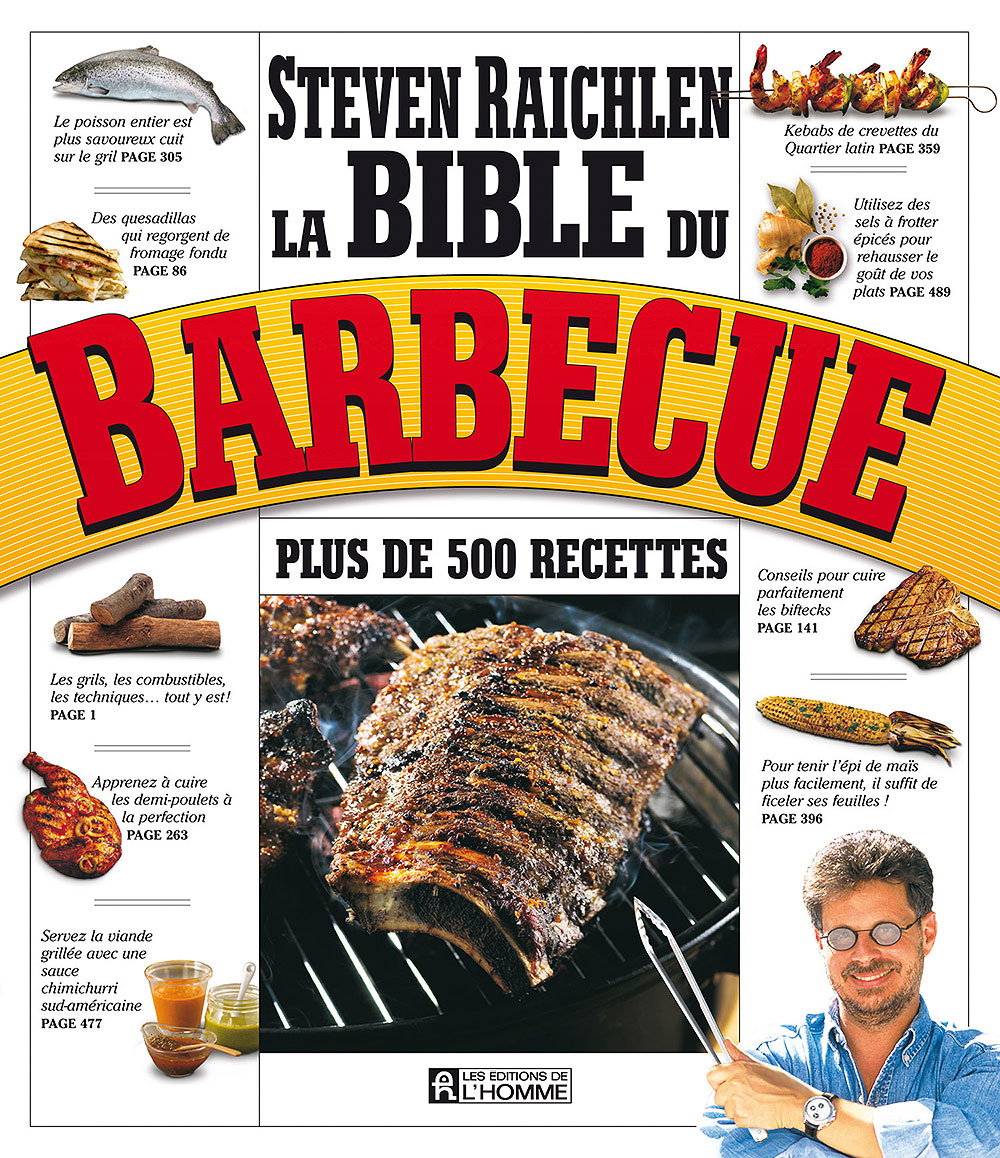
Since then, The Barbecue! Bible has been through two major revisions, five different covers, and has gone from a black and white book with woodcuts (most cookbooks did not have color photographs when it was originally published) to full color. The food pictured on the cover went from grilled shrimp (two iterations) to baby back ribs (two iterations) to the monster beef ribs on the current edition. But most of the content has remained the same—and much to my astonishment, most of it has remained relevant.
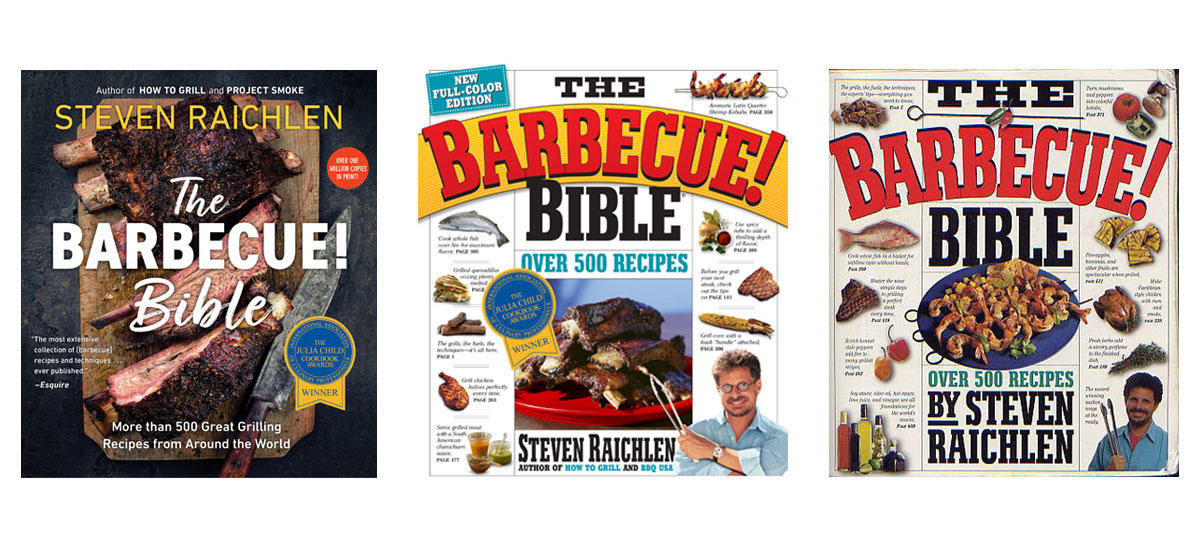
Over the years, people have asked lots of questions about The Barbecue! Bible and how I wrote it. Here are some of my favorites. (Tip ‘o the hat to the Smoke Sheet, which transcribed some of my responses for a recent newsletter.)
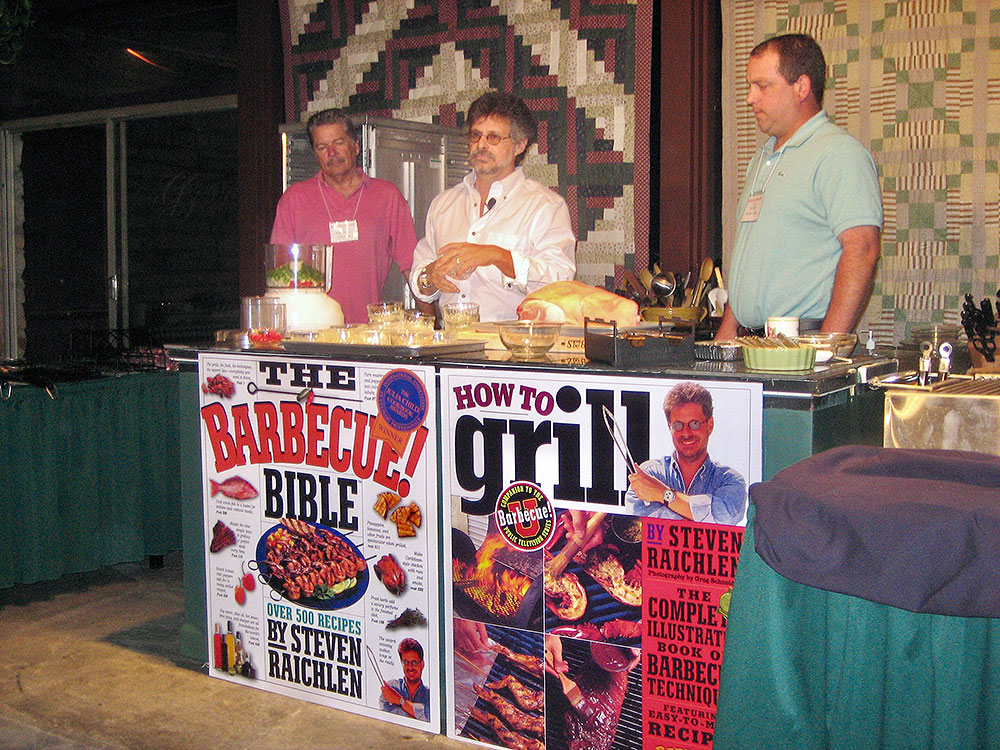
Do you have a question about the writing of The Barbecue! Bible? Please write us via Social Media (see below) I promise to answer all of them.
Was The Barbecue! Bible your original title?
Actually, I wanted to call the book Barbacoa—which many people know now was the Arawak Indian word that gave us our term barbecue. At the time, I doubt the book would have sold more than 100 copies with an obscure name like Barbacoa. When Workman’s Spring book catalogue came out in the fall of 1997, they had my book—my precious book—listed as The Great Big Backyard Barbecue Book. I freaked out, as you can imagine! We went back and forth on dozens of titles. Finally, someone at Workman said, “Hey, this thing is as thick as the Bible.” Thus my gospel of grilling became the Barbecue! Bible and so it has been ever since.
What’s with the exclamation mark?
My visionary publisher, the late Peter Workman, took a two-pronged approach to publishing. He loved big, thick, exhaustively comprehensive books, like What to Expect When You’re Expecting. And he loved funny, quirky, little books like the Belly Button Book by Sandra Boynton and The Preppy Handbook—Peter’s first million copy bestseller. If I had to sum up Peter’s enduring contribution to American publishing—and the key to his phenomenal success—it would be whimsy. Even his serious book had a whimsical element—hence the ! in Barbecue! Bible. For the record, I hated the !—I still do. I always felt it took away from the seriousness of the book. After a million plus copies sold, I guess Peter can rest his case.
How did you do the research to find restaurants, grill masters, and recipes on your travels?
The first thing I did on signing the book contract was to buy a roll-aboard suitcase. I knew I’d be traveling a lot—and to this day, whenever I start a new book, I pull out my suitcase. Hard as it is to believe, back then we had no Google or Internet. So I consulted ethnic chefs and food writers in the U.S., academics, tourism boards, hotel concierges—in short, anyone who knew anything about the local gastronomy. When multiple sources suggested a place to visit, I added it to my hot list. Taxi drivers (we didn’t have Ubers back then) were an invaluable source of information. I’d ask them to take me not to the tourist places, but to the grill joints where they ate. That’s how I discovered the restaurant Mitla in Juarez—home of the Steak from Hell.
What about countries you couldn’t visit?
Unfortunately, some of the world’s most interesting grilling cultures happen to be found in war zones or in countries that were sworn enemies of the U.S. The short list when I wrote Barbecue! Bible included Iran, Iraq, and Afghanistan. My work-around was to find Irani, Iraqi, and Afghan restaurants and chefs in the U.S.
What’s the strangest use to which The Barbecue! Bible has been put?
I once met a married couple at Barbecue University (the workshop I run for aspiring grill masters) who swore The Barbecue! Bible was the first brick laid in the foundation of their relationship. The book accompanied them on their first date and officiated at their wedding.
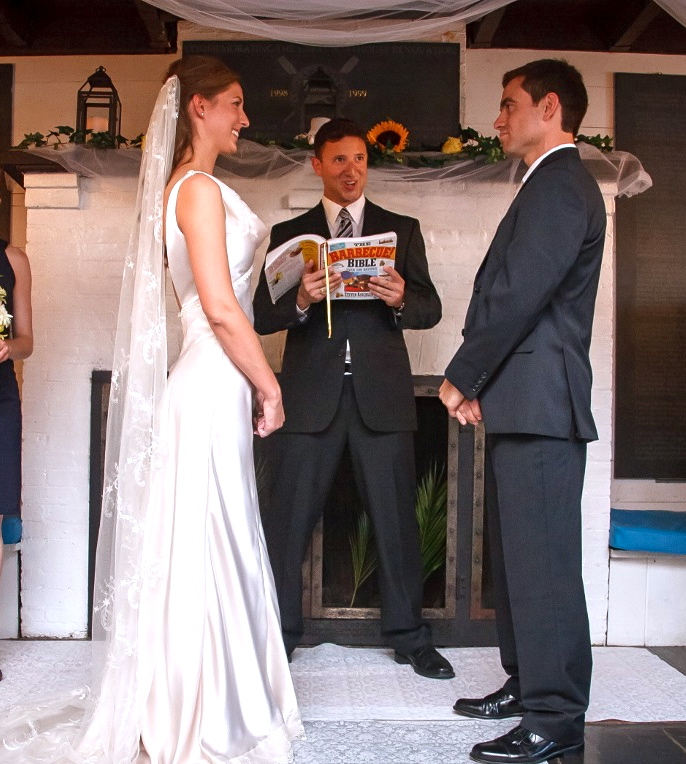
How has grilling changed since The Barbecue! Bible was first published?
First of all, barbecuing has gone from being a special occasion or weekend occasion to an every night phenomenon. The grill has become an extension of our kitchens. Simultaneously, when I started, people thought of barbecue as the hunk of protein at the center of the plate. Now we grill everything from appetizers to desserts to breakfast. Vegetables and seafood have assumed a huge role in contemporary grilling as well. Another big change is the notion of global grilling, which is really the subject of The Barbecue! Bible. Today, we think globally when we grill, but we certainly didn’t 25 years ago. Saté, tandoori, asado—those were really exotic when the book came out. The fourth big change is the increased sophistication of our own knowledge and practice in grilling. Back when the book first came out, I had to explain to people what the difference between grilling and barbecue was. Few people, especially those who grew up on the issue of shallow pan grills, understood indirect grilling. Our technical prowess and grill skills have skyrocketed along with our knowledge. In the 25 years since The Barbecue! Bible came out, we’ve gone from kindergarten to grad school.
How has The Barbecue! Bible changed grilling in America since its publication?
I like to think the book helped usher in what I call the Golden Age of Grilling. We’re now comfortable with all five methods of live-fire cooking (direct grilling, indirect grilling, smoking, spit-roasting, and ember-grilling). Many of us now grill, not just on special occasions, but 4 to 6 nights a week. More than 30 percent of American families now own more than one grill (and often a smoker). Grill restaurants have entered the fine dining sphere and even earn Michelin stars.
What are some of the underrated regions and countries when it comes to BBQ and grilling?
For starters, Africa, which is ironic, because according to archeological evidence, that’s where humans first learned to cook food with live fire. Even back then, The Barbecue! Bible chronicled the grilling of western and southern Africa, for example, yassa from Senegal,, which uses a tangy mustard-based marinade on grilled chicken and grilled fish. Or stick meat from Nigeria, which consists of beef or goat kebabs seasoned with fiery chiles and ground-up bouillon cubes.
Uruguay is often overlooked next to Argentinian asado, but this tiny nation of 3.5 million people plays an oversize role in South American grilling. Turkey has an incredible diversity of wood oven breads and kebabs. (Our word shish kebab comes from the Turkish words for “sword” and “meat.” Ditto for Indonesia. I don’t think people realize that there are probably 400 different kinds of satay in Indonesia.)
What’s your favorite recipe in The Barbecue! Bible?
I call this the ‘favorite child question,’ and while on any given day, you might prefer one child to another, you really love all your children equally. So it is with the recipes in the Barbecue! Bible. Off the top of my head, I love the Vietnamese Gilled Beef and Basil Rolls, the Spicy Thai Beef Salad, the South African Piri Piri Chicken, and the Memphis-Style Ribs.
But I’ll highlight a recipe that Food & Wine magazine included in their list of the 40 best recipes of the last century. It’s a ridiculously simple recipe that includes not one ounce of steak, brisket, or pork shoulder. It’s called Catalan Grilled Tomato Bread. You start with slices of gorgeous country-style bread, which you toast on the grill and give to your guests. Each guest also receives a garlic clove and half of a juicy, red, ripe tomato. You rub the hot toast with garlic, then with tomato, squeezing the juices into the bread. Drizzle with extra virgin olive oil, then sprinkle with sea salt and freshly ground black pepper. The result is out of this world. I still make Catalan tomato bread when people come over. It’s a great icebreaker because everyone gathers around the grill, participating in its preparation. You probably have the ingredients at home right now. And it never fails to delight.
So, what’s next for Steven Raichlen?
My next book, tentatively entitled Project Plancha, will focus on cooking on a hot metal slab—known as a plancha in Spain, teppan in Japan, and a griddle in North America. More and more, I’ve been cooking on a griddle on my grill. I recently wrote a story for the New York Times about the new stand-up outdoor griddles launched by big name grill companies like Traeger and Weber. I’m still cooking outdoors, but with an entirely new set of gear and techniques. I’m super-excited.
I hope you’ll join me in celebrating the 25th anniversary of The Barbecue! Bible. It’s a book that changed my life, and I hope it changed or will change yours! And on the unlikely (!) chance you don’t own it, you can order a copy here.
Sign up for our Up in Smoke newsletter so you don’t miss any blogs and receive some special offers! PLUS get Raichlen’s Burgers! PDF for free!
Follow Steven on Facebook, Twitter, Reddit, Instagram, and TikTok!
The post Happy Birthday, Barbecue Bible!! appeared first on Barbecuebible.com.
------------------------------------------------
By: Daniel Hale
Title: Happy Birthday, Barbecue Bible!!
Sourced From: barbecuebible.com/2023/06/12/happy-birthday-barbecue-bible/
Published Date: Mon, 12 Jun 2023 13:03:38 +0000




